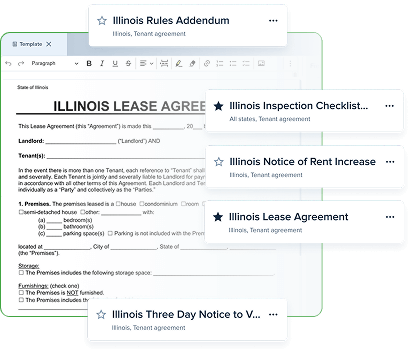Inspection Checklist Addendum
It takes more than just writing and signing a lease agreement and handing over the keys to successfully move tenants into a new property.
Depending on local laws, landlords may be required to conduct a rental property inspection before tenants move in and then again when they move out.
An Inspection Checklist Addendum is an important document used to identify damage to a property beyond normal wear and tear.
Inspection Checklist Addendum
Hold your tenants accountable for any damage.Generate a document with our document builder
Customize it using auto-fill elements if needed
E-sign and require signatures from tenants
What you need to know
What is a Move-in Inspection?
A landlord might use the move-in checklist to keep track of the state of their property. The checklist guarantees that the property will be inspected properly for damage and nothing will be missed or overlooked.
Above all, a Move-in Inspection holds tenants responsible for any damage incurred while they are living in a rental unit. Landlords typically document the status of their property both visually and in writing. A detailed description of each room must be included on the rental move-in inspection checklist, including any outside elements.
What is a Move-out Inspection?
For both landlords and tenants, a move-out checklist is a document that includes all of the critical parts of a complete move-out inspection. Landlords should offer renters a unit-specific inspection checklist. A property might, for example, have a unique amenity such as a log-burning fireplace. Before moving out, the landlord may demand the tenant remove any logs, extra soot, and debris left in the fireplace.
If the lease agreement includes Move-out instructions, both landlords and tenants must follow them. These instructions aid in the avoidance of complications following the move-out. Tenants abandoning furniture, leaving a filthy apartment, or even misplacing or losing keys are all examples of potential issues.
What should be included in the Move-in Inspection Checklist?
Rooms should be separated on the move-in checklist. The checklist for each room comprises the space's most common elements. The kitchen checklist, for example, contains objects such as the refrigerator, dishwasher, cupboards, and so on.
We recommend including the following rooms in the checklist:
Living room
Dining Room
Kitchen
Two Bedrooms
One Bathroom
Miscellaneous (parking, storage, apartment door, etc.)
Leave some space at the bottom of the checklist for any extra information.
It's easy to overlook minor details during the inspection, as there are so many steps involved in filling a vacant rental property. Make sure to note concerns such as the state of the carpet, damaged bathroom tiles, or markings on the wall using the shorthand in the key below.
Typical Abbreviations and key:
NC Needs Cleaning
NSC Needs Spot Cleaning
NP Needs Painting
NSP Needs Spot Painting
NR Needs Repair
PRNeeds Replacing
The landlord and tenant must both sign the paper after the checklist is completed. If any damage necessitates withholding the security deposit, having a signed checklist will help avoid problems down the road.
What should be included in the Move-out Inspection Checklist?
Before a landlord conducts a Move-out Inspection, they should undertake a Move-in Inspection before the current tenant moves in. It enables the Move-out Inspection checklist to validate that everything in the unit is in the same condition as it was at the beginning of the lease term. Regardless of the circumstances, tenants and landlords should rigorously follow the lease agreement's Move-out laws and standards. The agreement binds both landlords and tenants legally. If there is a disagreement, have time-stamped images on hand. These will assist landlords in ensuring that the argument is supported by evidence.

